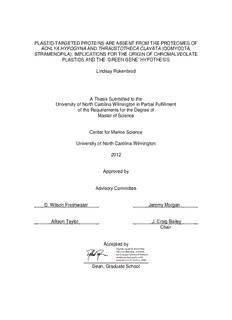Table Of ContentPLASTID-TARGETED PROTEINS ARE ABSENT FROM THE PROTEOMES OF
ACHLYA HYPOGYNA AND THRAUSTOTHECA CLAVATA (OOMYCOTA,
STRAMENOPILA): IMPLICATIONS FOR THE ORIGIN OF CHROMALVEOLATE
PLASTIDS AND THE ‘GREEN GENE’ HYPOTHESIS
Lindsay Rukenbrod
A Thesis Submitted to the
University of North Carolina Wilmington in Partial Fulfillment
of the Requirements for the Degree of
Master of Science
Center for Marine Science
University of North Carolina Wilmington
2012
Approved by
Advisory Committee
D. Wilson Freshwater Jeremy Morgan
Allison Taylor J. Craig Bailey
Chair
Accepted by
Dean, Graduate School
This thesis has been prepared in the style and format consistent with the Journal of
Eukaryotic Microbiology.
ii
TABLE OF CONTENTS
ABSTRACT .....................................................................................................................iv
ACKNOWLEDGMENTS ..................................................................................................vi
DEDICATION ................................................................................................................. vii
LIST OF TABLES .......................................................................................................... viii
LIST OF FIGURES ..........................................................................................................ix
CHAPTER 1: Implications for the origin of chromalveolate plastids ............................... X
INTRODUCTION .................................................................................................. 1
METHODS............................................................................................................ 3
RESULTS AND DISCUSSION ............................................................................. 4
Revised Hypotheses for the Evolution of Chromalveolate Plastids ............ 6
CHAPTER 2: Do chromalveolate genomes encode ‘green genes’? ............................ 15
INTRODUCTION ................................................................................................ 16
METHODS.......................................................................................................... 18
RESULTS AND DISCUSSION ........................................................................... 19
Green Genes in Oomycetes and Other Chromalveolates? ...................... 22
SUPPLEMENTAL INFORMATION................................................................................ 32
LITERATURE CITED .................................................................................................... 41
iii
ABSTRACT
Chapter 1
The chromalveolate hypothesis predicts that extant nonphotosynthetic stramenopiles
are secondarily nonphotosynthetic and derived from ancestors bearing a secondary red-
type plastid. To test this hypothesis, proteomes of the oomycetes Achlya hypogyna and
Thraustotheca clavata were canvassed for plastid-targeted genes. Proteins for each
species encoding putative plastid-targeting signal peptides were identified, annotated,
and assigned to protein families if possible. Forty-six candidate proteins were culled
from the two genomes. Bioinformatic analyses revealed that the proteomes of Achlya
and Thraustotheca do not encode plastid-targeted genes acquired by endosymbiotic
gene transfer. All proteins possessing non-mitochondrial-targeting signal peptides
identified were judged to belong to the secretome (i.e, extracellularly secreted proteins).
These results indicate that oomycetes are ancestrally aplastidic stramenopiles and do
not support the chromalveolate theory of plastid evolution. Revised hypotheses for the
origin of plastids characterized by chlorophylls a and c and fucoxanthin are presented. It
is concluded that alveolate and stramenopile plastids are likely tertiary or higher order
plastids, not secondary plastids.
Chapter 2
The hypothesis that a green algal symbiosis preceded the red algal symbiont that gave
rise to red-type plastids in the ancestors of the chromalveolates is reexamined. A
network approach was used to detect nuclear encoded proteins from the genomes of
Achlya hypogyna, Thraustotheca clavata, other oomycetes, and other chromalveolates
iv
that cluster with green algal genes. Twelve oomycete proteins clustering with green
algal genes at high stringency were annotated and selected for further analyses.
Representative homologs from all other eukaryotic taxa available were aligned to
sequences comprising each network and maximum likelihood trees were constructed
from these alignments. Protein trees derived from these data exhibited obvious errors
resulting from taxon biases and heterotachy. These results argue that ‘green genes’
detected in phylogenomics studies are artifactual and not indicative of endosymbiotic
gene transfer.
v
ACKNOWLEDGMENTS
My thanks go to my advisor, Dr. J. Craig Bailey, whose enthusiasm about
molecular protistology caught my interest in the very beginning of my scientific
education. His continuous encouragement, wit, and sense of humor made this journey
an enjoyable one. Ian Misner and Dr. Chris Lane of the University of Rhode Island have
also been instrumental in my education, providing feedback and technical support in my
research. I’d also like to thank my committee members, Dr. D. Wilson Freshwater, Dr.
Jeremy Morgan, and Dr. Allison Taylor, for their encouragement and flexibility
throughout this process.
My lab mates past and present, particularly Cory Dashiell, Erika Shwarz, Ashley
Hayes, and Allison Martin, helped me maintain my focus over the years throughout
failed DNA extractions, computer malfunctions, approaching deadlines, and many other
graduate school related challenges.
The Department of Biology and Marine Biology, the Center for Marine Science
and the National Science Foundation provided financial support for my education and
research.
Finally, I’d like to thank my parents and my husband for supporting me every step
of the way.
vi
DEDICATION
I’d like to dedicate this to my mother, whose endless patience has allowed me to
explore life with few restrictions and overwhelming love and support.
vii
LIST OF TABLES
Table Page
Chapter 1
1. Protein IDs for 46 hypothetical proteins detected in the genomes of
Thraustotheca and/or Achlya.. ............................................................................ 9
2. Protein ID numbers, annotations and protein family designations.. ................... 11
3. Proteins sorted into one of 14 unique protein families.. ..................................... 13
4. List of seven proteins from the Achlya and Thraustotheca and putative
homologs found in the Arabidopsis thaliana plastid proteome.. ........................ 14
Chapter 2
1. List of 12 annotated proteins from the Achlya and/or Thraustotheca proteomes
or other oomycetes found in EGNs . ........................................................................ 24
viii
LIST OF FIGURES
Figure Page
Chapter 1
1. Hypotheses for the origin of complex, higher order
chlorophyll a+c-containing plastids in chromalveolates. ....................................... 8
Chapter 2
1. Three examples of putative green genes in oomycete
genomes based on EGN analysis. .................................................................... 25
2. DEXDc ML tree ................................................................................................... 26
3. RPB ML tree ....................................................................................................... 27
4. ALDH ML tree ..................................................................................................... 28
5. TOR-containing kinase ML tree .......................................................................... 29
6. YAK1 ML tree: .................................................................................................... 30
7. ALS ML tree....................................................................................................... 31
ix
CHAPTER 1: Implications for the origin of chromalveolate plastids.
x
Description:plastid-targeted proteins are absent from the proteomes of achlya hypogyna and thraustotheca clavata (oomycota, stramenopila): implications for the origin of

